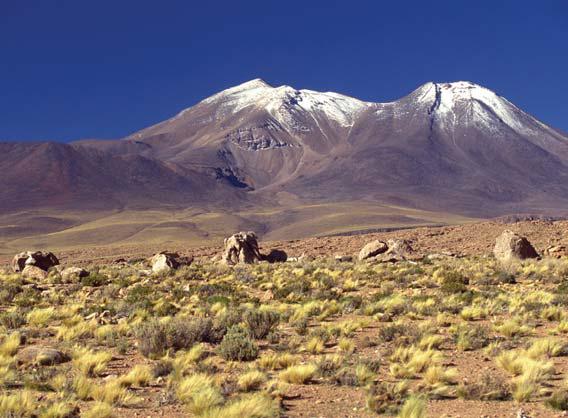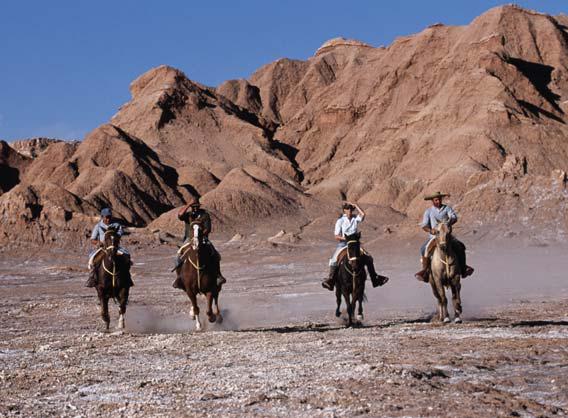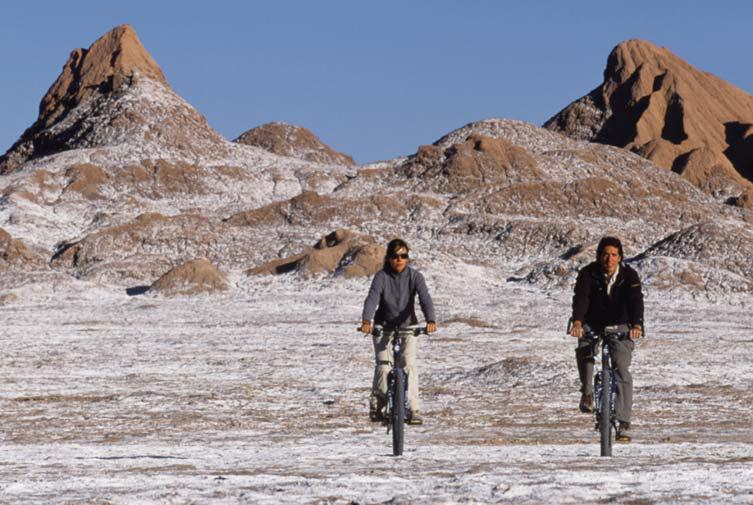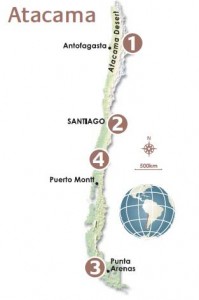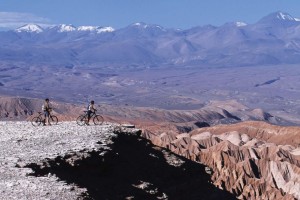 Wtih a final clattering of hooves on rock we come to a halt at the edge of a precipice. A thousand feet below us, the wind-eroded peaks of the Salt Mountain Range glint in the evening sun. It has taken our horses an hour to pick their way, with sure-footed assurance, up the narrow dusty trail that rises steeply from the valley below. Before us, the Atacama Desert stretches out like an open book. Looking beyond the Salt Mountains we see the Salar de Atacama, a smudge of grey extending to the horizon. Chile’s largest salt flat, the Salar is a vast depression where flamingos as tall and thin as Chile itself browse for plankton amid a mosaic of crystallised salt and small lagoons. At its northern tip, a splash of green amongst the burnt landscapes identifies the oasis of San Pedro de Atacama. Our eyes turn eastwards, to the great umber curtain of the Andes. Head and shoulders clear of the surrounding peaks, the perfect cone of Volcan Licancabur dominates the mountain range. Nothing prepares you for the austerity or variety of the Atacama, reputedly the driest desert on earth.
Wtih a final clattering of hooves on rock we come to a halt at the edge of a precipice. A thousand feet below us, the wind-eroded peaks of the Salt Mountain Range glint in the evening sun. It has taken our horses an hour to pick their way, with sure-footed assurance, up the narrow dusty trail that rises steeply from the valley below. Before us, the Atacama Desert stretches out like an open book. Looking beyond the Salt Mountains we see the Salar de Atacama, a smudge of grey extending to the horizon. Chile’s largest salt flat, the Salar is a vast depression where flamingos as tall and thin as Chile itself browse for plankton amid a mosaic of crystallised salt and small lagoons. At its northern tip, a splash of green amongst the burnt landscapes identifies the oasis of San Pedro de Atacama. Our eyes turn eastwards, to the great umber curtain of the Andes. Head and shoulders clear of the surrounding peaks, the perfect cone of Volcan Licancabur dominates the mountain range. Nothing prepares you for the austerity or variety of the Atacama, reputedly the driest desert on earth.
At first glance, driving through, it appears hostile and uninteresting, an endless plain of sun-baked rock and dust between the ragged coastline and the brooding Andes. It has places where no rainfall has ever been recorded. Much of it is devoid of life, with not a tree or shrub, nor even a blade of grass, to provide relief. Dusty one-horse villages, exposed to wind and sun, isolated in this harsh wasteland, endure the desert’s ravages. Yet look closer, follow faint dirt tracks that snake their way into sheer-sided ravines, and you will find villagers cultivating lush green terraced plots and shady orchards. The contrasts can be shocking. The hub for exploring the Atacama is the village of San Pedro de Atacama. Once an important resting point for mule and llama trains on the trading route between the fishing communities of the coast and the pastoralists of the altiplano, San Pedro has at varying times been under the control of several of South America’s great cultures: Tiwanakus, Incas and Spanish conquistadores.
Today it has a population of around 1,000 Atacamenos. At the centre of the village is a fine Andean church, whose whitewashed adobe walls and distinctive bell-tower stand proud against the piercing blue desert sky. Beside the church, a ring of ancient pepper trees shades a small paved village square. Narrow streets radiate outwards. Many of the old mud-brick houses have been converted to hotels, residenciales, restaurants and adventure outfitters who offer horse-riding, trekking, mountain biking and four-wheel-drive tours into the desert. Despite its many visitors, San Pedro has a quiet old-world charm and an unhurried pace of life. The oasis is segregated into neighbourhoods, based around close-knit families. Follow the winding lanes and you get a glimpse of traditional Atacamenan life, as you encounter farmers on horseback driving flocks of sheep and goats, or look over a rustic fence to see people tilling the ground by hand. You do not have to venture far beyond the edge of this oasis to experience the true rawness of the Atacama. We cycled out to Valle de la Luna (Moon Valley), a Tolkeinesque landscape of bizarre twisted rock extrusions and fluted sand faces. The ground glittered with crystals of salt and mica. Leaving our mountain bikes, we hiked up a narrow gorge that cut deep into the Salt Mountains. Recent rain had exposed sheets of crystal in the sheer rock walls, which popped audibly as they expanded in the morning heat. We continued along the gorge, enjoying the welcome shade, until the debris of a massive rockfall blocked our way and we had to turn back.
Further afield, it takes a full day of driving to climb up onto the altiplano and visit the high altitude lagoons. It is a great journey, along the side of the Salar, passing through numerous small villages with their adobe churches and hidden orchards before climbing steadily up the lower flanks of the Andes. After the barrenness of the lower plains, the altiplano feels joyously colourful and alive. Tussocks of golden grass and clumps of rosetinted cactus carpet the landscape. Herds of vicunas, wild camellids of the llama family valued for their fine wool, appear as tiny specks in this expansive scenery. The air becomes thinner and thinner, making even the slightest activity an effort, and then, just as you think the oxygen is about to run out, you are confronted by the lagunas, each pool a vivid shade of blue – turquoise, aquamarine, lapis lazuli – overlooked by mountain summits. In the dry air, their colours are so intense they seem unbelievable. Another long vehicle journey, to the north of San Pedro, takes you to Tatio, the highest geyser field in the world. Here at dawn, shafts of sunlight clamber over the Andes and illuminate the geysers’ rising steam trails, catching on droplets of spouting water and making them sparkle like diamonds. Whilst 4×4 vehicles provide access to the Atacama’s far-flung reaches, it is on foot, mountain bike or horseback that you can get closest to the desert. Scrambling up high dunes, hiking remote canyons, riding long mountain ridges – it is with the sun on your back and the wind on your face that you find the soul of this extraordinary place.
- San Pedro De Atacama Explore the bizarre lunar landscapes surrounding this charming town in the heart of the Atacama Desert, one of the driest places on earth.
- Santiago Watch the world go by in this bustling cosmopolitan capital, or in winter head out to the cordillera ski fields at Valle Nevado and Portillo to tackle some of the highest commercial peaks in the world.
- Torres Del Paine Explore this beautiful national park in southern Chile, noted for its many lakes, glaciers and rocky peaks, and the centrepiece of which are the majestic 2,000-metre granite pillars that give the park its name.
- Pucon Get active in the adventure sports centre of the country, located in the heart of Chile’s fabulous Lake District. The scenic region of lush farmland, dense forest, snow-capped volcanoes, waterfalls and clear lakes, offers superb whitewater rafting, fishing, horse riding, mountain biking, as well as the chance to spot the rare puma.
- Easter Island Stand beneath one of the colossal and mysterious stone moais on Rapa Nui, as the world’s most remote inhabited island (3,790 kilometres west of the Chilean mainland) is known locally. All the while, wondering just how these giant structures got there. (Not shown on map.)
Websites
www.gochile.cl Useful site dedicated to all things Chilean, covering attractions, transport, accommodation and activities. Features good general maps.
